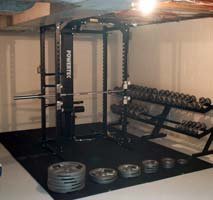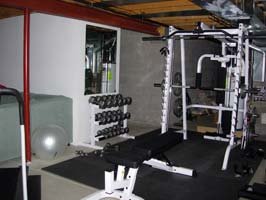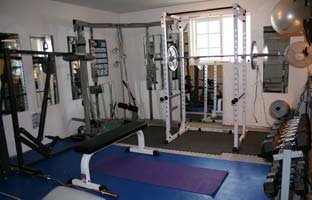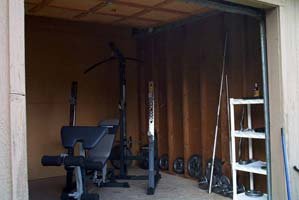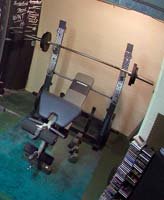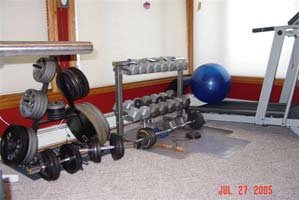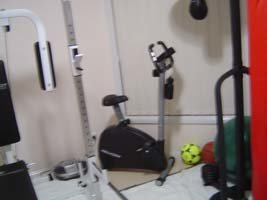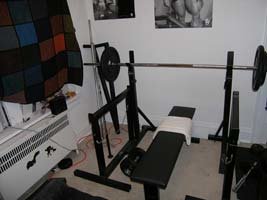
TOPIC: How Can You Create An Effective Home Gym On A Budget?

The Question:
Due to lack of time, distance from a health club, or hectic work hours not everyone is able to train at a commercial gym. Building a home gym can help solve this problem.
How can you create an effective home gym on a budget?
Which type of exercise equipment should one buy if they are limited on space?
What is the biggest advantage and drawback to having a home gym compared to having a membership?
Bonus Question: Do you have a home gym? If so, what does it consist of? If not, would you consider one?
Show off your knowledge to the world!
The Winners:
- Xtrainer View Profile
- randommagic View Profile
Prizes:
- 1st place - 75 in store credit.
- 2nd place - 50 in store credit.
- 3rd place - 25 in store credit.

1st Place - Xtrainer
View This Author's BodySpace Here.

Let's get one thing clear right off the bat: Home gyms rock, through and through. They are not to be thought of as a "last resort" or a "back-up plan" to a "real gym" workout. A home gym can be just as effective as a so-called "real" gym. In fact, home gyms have several benefits over commercial gyms.

Home Gym On A Budget
How Can You Create An Effective Home Gym On A Budget?
One of the great things about home gyms is individualization: You mold them to fit your particular goals and tastes. Therefore, no two home gyms should be exactly alike. Here are a few questions to consider as you plan your home gym:

1. What Is Your Fitness Goal?
This is the defining question regarding your home gym. As a combat athlete, my gym contains sport-specific training tools like a heavy bag as well as "conventional" strength training equipment, like weights.
What is your goal? For example, if you are a combat athlete like me, you may want a heavy bag yourself. If, however, you plan to run marathons, a heavy bag probably should not be your first consideration. Get your goals in line first and foremost.

2. What Do I Already Have Available? 
I'll never buy a treadmill. I live in a rural area with plenty of room to run outdoors. If, however, you live on a busy street or in an area with frequent inclement weather, a treadmill may be a valuable addition to your gym. Likewise, consider the role of your home gym:
Will it be your only gym (used frequently), used in conjunction with a commercial gym, or only used occasionally? If you already have a commercial gym membership, it makes sense to compensate for your gym's shortcomings. My commercial gym, for example, has little room for doing Olympic lifts, so I made sure to get a barbell so I could train cleans and similar lifts at home.
My commercial gym does, however, have plenty of bench pressing stations, so getting a bench pressing apparatus was not a priority. Further considerations: Is the room itself fit for lifting? Is the floor durable (and do you care)? Is the ceiling so low that it will interfere with overhead lifting? Take stock of your circumstances and cover your bases.

3. Is This Safe?
One of the few downsides of working out at home is the lack of a spotter or training partner. This can make for some dangerous situations if you are not careful. Some things are just stupid: Don't go for a 20lb PR on your bench when you're home alone.
People have died doing that. In fact, you may decide to save all of your benching for the commercial gym. How does this decision affect your home gym? Well, obviously, you just made a decision not to get a bench pressing apparatus.
For any of the exercises you would consider doing at home, make sure that you can perform them safely under the conditions in your home gym. If you cannot perform those movements safely, cross them off the list, along with the relevant equipment-assuming that equipment does not have other uses. Obviously, the barbell you use for bench pressing has more than one use!

Building Your Gym...
So you've thought the previous three questions through thoroughly and now its time to go to the sporting goods store, right? Well, maybe. But you want to get the best bang for your buck, so check out classifieds websites. You may be able to score some free or deeply discounted equipment! What kind of equipment? Well...

 Olympic Barbell w/Plates:
Olympic Barbell w/Plates:
This is an absolutely essential piece of equipment for the home gym. Why do barbells reign supreme?
- Barbells and plates are cheap. Even at retail price, a barbell with a couple hundred pounds of weight will cost around $100. Machines run well into the thousands.
- Barbells allow for progression of weight. Simply add more plates. You can't say the same for machines or fixed-weight dumbbells.
- Barbells are extremely versatile. There absolutely no machine out there that has half the functions of a barbell, not even at quadruple the price!
- Barbells are effective for building functional strength and muscle.
- Bands break, leather tears, cables shred, iron... lasts pretty much a lifetime. Take care of your weights and they'll serve you for years to come.
- Barbells allow you to move big poundages. I'm all for heavy dumbbell training, but when you're going heavy, sometimes you just need a barbell.
- The plates themselves can be used for numerous exercises (weighted sit-ups, Russian twists, etc.).

 Adjustable Dumbbells w/Plates:
Adjustable Dumbbells w/Plates:
Dumbbells are a close second to barbells in the hierarchy of essential home gym equipment. Adjustable dumbbells have many of the same advantages of barbells: They're cheap, versatile, functional, and durable.
I consider them slightly less important than a barbell simply because changing the weight takes a little more time and effort, and they become impractical for higher poundages (dumbbells over 100 pounds or so are often simply too bulky to use a full range of motion for many exercises).
Note that I recommend adjustable dumbbells. Unless you have loads of disposable income, fixed weight dumbbells are a poor choice for your home gym. If you train with fixed weight dumbbells you will either:
- Shell out more cash for bigger dumbbells as you get stronger OR
- Stagnate.
Neither option is very exciting, is it?
Before I go on, you could stop here and have an excellent home gym. In fact, if you picked just one of the above two training tools, you are now equipped to have a much better workout than the one that 90% of the commercial gym clientele gets. Barbells and dumbbells are rock-solid basics. Everything else is just icing on the cake.

 Squat Rack/Power Cage:
Squat Rack/Power Cage:
This is certainly a bit of an investment, but it can give you additional training flexibility and safety. For example, without a rack, you would have to perform a power clean in order to perform overhead presses, and back squats would be extremely awkward.
While a rack does give you extra latitude in your exercise selection and performance, I should reiterate my feelings on the dangers of lifting alone. For example, having a squat rack does not mean you should be attempting anywhere near personal record back squats alone at home. It is still dangerous and I highly advise against it.
If you choose to squat relatively heavy weights at home, I suggest front squats. If the weight is too heavy, just lose the bar.

 Pull Up Bar:
Pull Up Bar:
One of the few great exercises that cannot be performed with dumbbells or barbells is the pull-up. Bear in mind that you may already have a sturdy bar, beam, or even a tree somewhere in your house or yard, making this investment unnecessary.
There are several types of pull-up bars out there. Some mount inside of a door frame. Others attach directly to a wall. Still others are free-standing. As an added bonus, many of these free-standing units also have dip bars, allowing you to perform another great movement.

 Medicine Ball:
Medicine Ball:
The medicine ball is an essential tool for the athlete. What could be more "functional" than lifting a 15lb ball above you head and slamming it onto the ground as hard as you can, only to catch it and repeat over... and over... medicine balls are great for developing muscular endurance and explosiveness. And they're cheap!

 Bench:
Bench:
A bench is a nice addition to your gym, but if money or space is short, it should not be a priority. A bench gives you a few more options as far as the lifts you may perform, and an adjustable bench gives you a few more still. However, you should be doing most of your lifting standing anyway, so a bench should be thought of a "nice" extra, not an essential.

 Grip Tools:
Grip Tools:
It's not uncommon for grip to become the limiting factor in some of your pulling lifts. A few cheap, simple grip training devices can take care of this problem.

 Mirror:
Mirror:
Mirrors are a handy tool to have to check your form on certain lifts. If, however, you exercise somewhat "violently," you probably know better than to keep anything breakable within a good 10ft radius of your workout area. Medicine balls may bounce awkwardly, sometimes you miss a clean, and sometimes you lower that overhead press a little faster than you meant too.

 Music:
Music:
I choose to keep a stereo system in the adjoining room, for the same reasons that I do not have a mirror in my gym. I don't always listen to music when I work out, but there's no doubt that it can be a valuable addition on those days when you're having a hard time getting "in the zone."

Wasteful Spending
 Machines:
Machines:
Machines are incredibly expensive, bulky, limited in function, and less effective than free weights. They're just not a cost effective training tool.
The latest ball, block box, mat, etc: There is so much of this crap out there. All of these little trinkets promise to get you in shape through somewhat dubious means.
Many of them make "core" training their selling point. Some of them are worthless. Others are just too narrowly focused to be a cost-effective tool or offer no progressive challenges. Steer clear of these products and stick with the basics: Heavy iron and hard work.

Limited Space
Which Type Of Exercise Equipment Should One Buy If They Are Limited On Space?
If space is at an absolute premium, you can go without the barbell and substitute dumbbell movements. Obviously, a cage or rack would be out of the question, and if you find yourself considering a machine, forget about it.
If you have room for a machine, you have room for a barbell and some plates. If you're truly limited on space, stop there. You can get a fantastic workout with dumbbells, barbells, and your own body (push ups, etc.).
A doorway pull up bar that could be stored away would take up very little space as well. Remember, having a spacious workout area is not incredibly important. You need only enough room to move weights around at arms length without breaking stuff. What is important is having the willingness to get into whatever space you have and work hard.

Advantages & Drawbacks
What Is The Biggest Advantage And Drawback To having A Home Gym Compared To Having A Membership?
The biggest advantage of having a home gym can be summed up in one word: Freedom. In your home gym, you have freedom from the distractions of a commercial gym. No other people, no other noise, just you and iron. You also have the freedom to train how you want. Dress how you want, grunt as loud as you want, blast the music as loud as you want and, oh yeah... lift how you want.
Some gyms even ban certain lifts because they are too loud, destructive, or disruptive, but at home, it is your gym and you can do as you like! You can treat the equipment however you want to. So what if that dropped clean put a dent in the floor? It's your floor, so you put as many dents as you want in it! It's your house, your gym, your rules. And don't forget the ultimate freedom: Freedom from membership dues!
The only real disadvantage is the lack of a spotter. Not only do you not have a spotter standing right there as you lift, but there is not even someone that can come running from across the gym if you get yourself into trouble. As the saying goes,
There is certainly an empowering element to working out in your own gym, but that power comes with a heft dose of responsibility. No one is watching your back, no one can call an ambulance if something happens. So train carefully and talk to your doctor as well as professionals in the fitness field.

Bonus Question
Do You Have A Home Gym? If So, What Does It Consist Of? If Not, Would You Consider One?
I do have a home gym, which I use for roughly half of my workouts. It consists of:
- An Olympic Barbell And An Ample Quantity Of Plates: I use it mainly for Olympic and overhead movements, while saving heavy squats, deadlifts, and bench presses for the gym.
- Two Adjustable Dumbbells and Plates: I use them primarily for one-arm Olympic movements.
- Medicine Balls: I have a nice sturdy wall for twist throws, and I also use these for endurance workouts.
- Heavy Bag: Not only do I punch and kick it, but I also use it as a lifting implement. Shouldering a heavy bag 50 times is a great full-body endurance workout in and of itself.
- Bench: Honestly, my bench functions mostly as a place to set my plates on. I occasionally use it for dragon flags or light bench pressing, but I do not consider it a core.
- Stereo: Because we all need loud music sometimes.
- Grip Tools: As a grappler, I feel it is essential to have a strong grip. Therefore, I have a variety of grippers and hand training devices.
- Jump Rope: I've only recently accepted the value of the rope as a training tool. It is great for both cardio and anaerobic workouts, and while I don't use it every day, it makes for a great change of pace.
- My yard/road: I have a relatively large backyard which takes me about 20 seconds to sprint across (*cough-Tabata-cough*). Sometimes I go for long runs on my road, and I even have a tree I can use for pull ups.

2nd Place - randommagic
View This Author's BodySpace Here.


Home Gym On A Budget
How Can You Create An Effective Home Gym On A Budget?
When building a home gym, the first thing that you have to look at is what exactly your goal is while working out. This will help guide you in what equipment you will need, and how much space you will need. If you are training for size and strength, you will need lots of weights, if you are training for endurance or speed you will need equipment related to that type of training.

Limited On Space
Which Type Of Exercise Equipment Should One Buy If They Are Limited On Space?
If you are limited on space you need to concentrate on getting the basics. A lot of the items you can find at garage sales in still good condition by people who no longer use them. For other equipment, for example getting enough weight to train with, it is best to go to a Sports shop or a place like that to buy it. Some stores online sell weight cheaply but the shipping costs can blow out any savings from that.
If you train to gain size and mass, you will need to get a reasonable amount of weight, 200-350 pounds is enough for most people. Always try and get about 50 pounds more than what you can currently handle at the moment so that you have room to grow. If you exceed this, you can by some more weight at a later date.
 Dumbbells & Barbells:
Dumbbells & Barbells:
A good quality set of Dumbbell and Barbell bars is also imperative, as cheaply made ones will tend to permanently bend over time as they won't be able to handle heavy loads of weight being put on it, especially for squats or bench presses.
 Weight Rack/Tree:
Weight Rack/Tree:
A weight rack/tree that you can stack the weight on is also useful to store your weights. It also does not have to take up much space if you use ones similar to the one on the right. Multifunction machines like a Nautilus Machine is usually not a good idea as they allow you to only have a limited range of motion, and also take up a lot of space.
 PowerBlock:
PowerBlock:
If you would like a faster way to load up your dumbbells with weight rather than the traditional way with plates you could go for something like the PowerBlock, which allows you to clip in additional weight with ease and is a lot faster than having to unscrew the rings at the end of dumbbells or barbells. It is usually a little bit more expensive, but comes in very handy if you are doing power sets and want to be able change weight fast.
 Squat Rack:
Squat Rack:
A squat rack is a necessary to have if you are serious about your home workouts as they are necessary for being able to perform heavy squats safely, especially if you won't be working out with a spotter to help you with your reps.
It should be third on your home gym shopping list after your weights and barbells/dumbbells if you are thinking of doing any heavy squats at all. It would be really good if it had a pull up bar on it as well so that you can perform pull-ups as well in your workout.
 Adjustable Bench:
Adjustable Bench:
An adjustable bench to do your chess presses on, as well as leg curls and extensions on is also a necessary basic that should be a staple in any home gym. This should be strong enough to be able to support you and the weight that you are working with.
 Punching Bag:
Punching Bag:
If you train for specific sports like boxing or triathlon you have to think about whether you want to get a punching bag and other equipment related to that specific sport.
 Cardio Machines:
Cardio Machines:
Cardio machines like treadmills or elliptical machines can be really expensive and take up a lot of room, especially if you are short on space. You can usually get them second hand in garage sales and the like, if you want one, but you can get just as an effective cardio workout by skipping rope for half an hour with a $5 skip rope, or go for a run if the weather is nice outside.
 Level Floor:
Level Floor:
The room that you will be using also needs to have a level floor. A lot of floors look level, but actually slope slightly. You don't want to putting your dumbbells down after some heavy dumbbell flyes, only to find that they have rolled away from you when you go to pick them up again for another set. Also a good quality surface that you can drop your weights on without damaging the floor is good for long term training.
 Optional Extras:
Optional Extras:
A small radio or sound system to play your music on while you train is an optional extra which can help you get in the mood of your workout and get you revved up to go for a couple more reps when there is good music going. Mirrors along one or more of the walls while a luxury, can aid you in watching your form, and making sure that you don't slack off on it.
A mat to do any floor workouts or stretching, is also useful to use rather than working out on a hard surface. Gloves to wear while training with weights is also good to have to help prevent calluses developing on your hands.

Advantages & Drawbacks
What Is The Biggest Advantage And Drawback To Having A Home Gym Compared To Having A Membership?
The biggest advantage to having a home gym is that you save on time traveling back and forth, as well as gym fees. All the equipment may seem expensive at first, but after 2 or 3 years you would have paid it off from all the money that you have saved from the gym membership you used to pay monthly, as well as transportation costs. You can also customize the equipment to your training needs, and get equipment that you actually use on a regular basis.
The biggest drawback is that sometimes you can lose motivation while training at home. With a commercial gym you can at least be with people that have a similar goal to yours which may encourage you and spur you on. There will be a wider range of machines and equipment that is out of reach of most home users wallets, and the environment will (sometimes) help you to be psyched about working out.
At home there may not be anyone there to encourage you on, and there will be plenty of distractions like the Basketball game on TV on in the next room.

Bonus Question
Do You Have A Home Gym? If So, What Does It Consist Of? If Not, Would You Consider One?
At the moment I don't have a home gym because I do not have the space for one. I will be moving soon, and on the checklist for a new place is a small room or area I can use to work out in.

